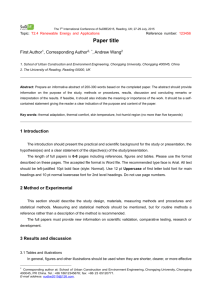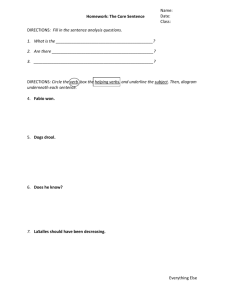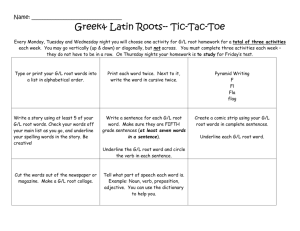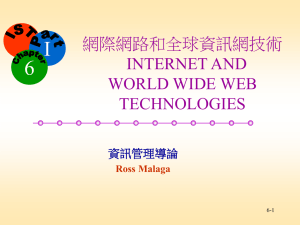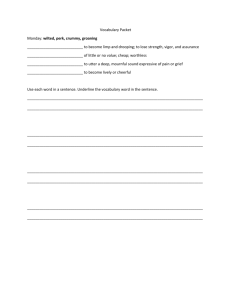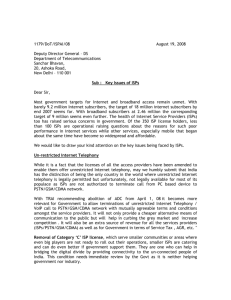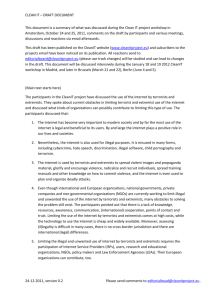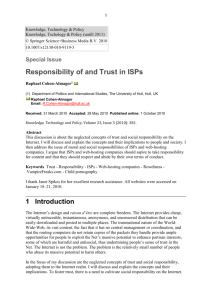Introduction to Computer Science Homework #2 Deadline: 2010/01
advertisement
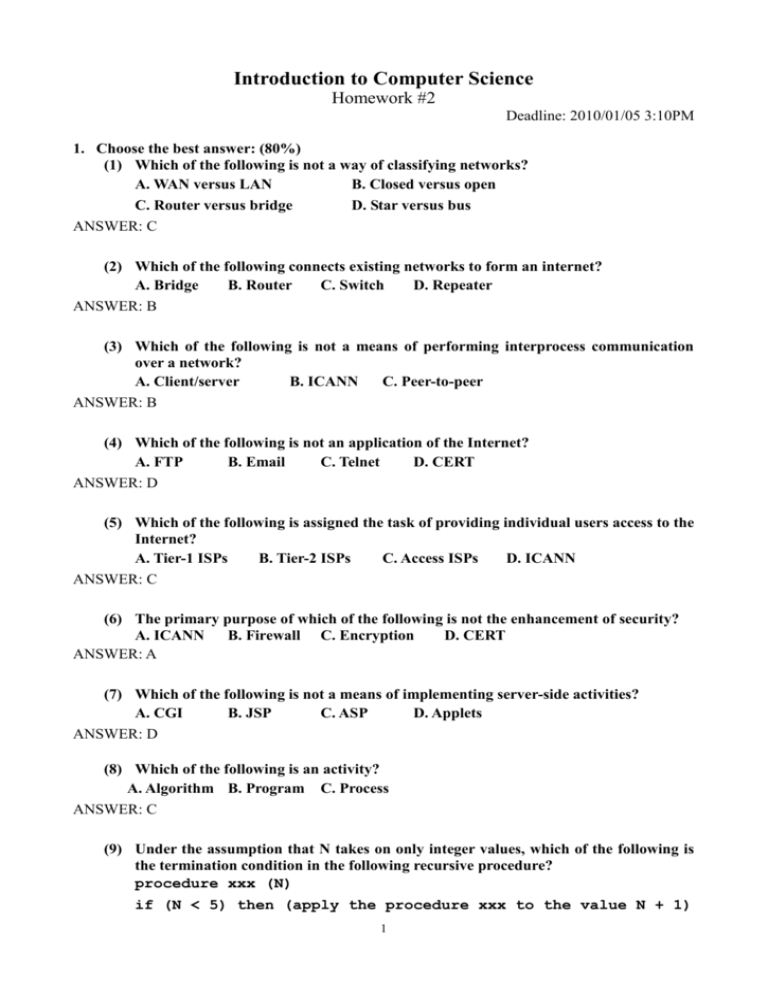
Introduction to Computer Science Homework #2 Deadline: 2010/01/05 3:10PM 1. Choose the best answer: (80%) (1) Which of the following is not a way of classifying networks? A. WAN versus LAN B. Closed versus open C. Router versus bridge D. Star versus bus ANSWER: C (2) Which of the following connects existing networks to form an internet? A. Bridge B. Router C. Switch D. Repeater ANSWER: B (3) Which of the following is not a means of performing interprocess communication over a network? A. Client/server B. ICANN C. Peer-to-peer ANSWER: B (4) Which of the following is not an application of the Internet? A. FTP B. Email C. Telnet D. CERT ANSWER: D (5) Which of the following is assigned the task of providing individual users access to the Internet? A. Tier-1 ISPs B. Tier-2 ISPs C. Access ISPs D. ICANN ANSWER: C (6) The primary purpose of which of the following is not the enhancement of security? A. ICANN B. Firewall C. Encryption D. CERT ANSWER: A (7) Which of the following is not a means of implementing server-side activities? A. CGI B. JSP C. ASP D. Applets ANSWER: D (8) Which of the following is an activity? A. Algorithm B. Program C. Process ANSWER: C (9) Under the assumption that N takes on only integer values, which of the following is the termination condition in the following recursive procedure? procedure xxx (N) if (N < 5) then (apply the procedure xxx to the value N + 1) 1 else (print the value of N) A. N < 5 B. N > 4 ANSWER: B C. N < 4 (10) Which of the following is not a way of representing algorithms? A. Stepwise refinement B. Pseudocode C. Flowchart D. Programming language ANSWER: A (11) Which of the following is a LIFO structure? A. Array B. Stack C. Queue ANSWER: D. Tree B (12) Which of the following is static in the sense that it does not change size or shape as information is stored and retrieved? A. Array ANSWER: B. Stack C. Queue D. Tree A (13) Suppose you were going to retrieve items of data that you would later need to process in the opposite order from that in which they were retrieved. Which of the following would be the best structure in which to store the items? A. Traditional linked list B. Stack C. Queue D. Tree ANSWER: B 2. (6%) Draw a circle the portion of the URL below that identifies the directory containing the file being addressed. Underline the portion that identifies the protocol that should be used when accessing the file. Draw a rectangle around the portion that identifies the file name itself. http://batcave.metropolis.com/heroes/superheroes/batpage.html ANSWER: Circle: superheroes, underline: http, rectangle: batpage.html (or just batpage) 3. (4%) Draw a rectangle around the portion of the email address below that identifies the “person” who should receive the message. Underline the portion that identifies the location of the mail server that handles the mail for that person. Fido@dogmail.zoo.org ANSWER: Rectangle: Fido, underline: dogmail.zoo.org 4. (6%) The main purpose of _______ and ________ ISPs is to provide a system of 2 high-speed routers that serve as the Internet’s communication backbone, whereas _________ ISPs concentrate on providing Internet access to the Internet’s users. ANSWER: Tier-1, tier-2, access 5. (4%) What bit pattern is represented by 33.42.18 in dotted decimal notation? ANSWER: 00100001 00101010 00010010 (212A12 in hexadecimal) 6. (8%) Fill in the blanks with the missing tags to the following HTML document. <html> <head> ______ Title </title> </head> _______ <p>Click on <a href=”http://this..org”> this. _______ ______ </body> </html> ANSWER: The following tags are missing: <title>, <body>, </a>, and </p>. 7. (8%) Identify two types of VoIP devices. ANSWER: Soft phones, analog telephone adapters, embedded VoIP phones, smartphones. 8. (4%) What is the difference between a repeater and a bridge? ANSWER: Both repeaters and bridges are used to connect two buses, but a repeater transfers all messages whereas a bridge transfers only those messages destined for the other side. 9. (4%) What is the primary difference between using Telnet and SSH to connect to a remote server? ANSWER: The SSH protocol encrypts communication to prevent network eavesdroppers from intercepting passwords or other sensitive information. 10. (6%) List three of the primitives in the pseudocode developed in this chapter. ANSWER: Possible answers include: the assignment statement using , the if-then-else statement, 3 the while statement, the repeat statement, and the definition and activation of procedures. 11. (4%) What sequence of values will be printed when the following instructions are executed? X 5; if (X < 7) then (print the value 6; Y 6) else (print the value 4; Y 4) if (Y < 5) then (print the value 3) else (print the value 2) ANSWER: 6, 2 12. (6%) What sequence of values would be printed if the procedure xxx described below were executed with the value of N being 9? procedure xxx (N) if (N < 4) then (print the value of N; apply the procedure yyy to the value 7) else (apply the procedure yyy to the value 2; print the value of N) procedure yyy (N) if (N < 5) then (print the value of N; apply the procedure zzz to the value 6) else (apply the procedure zzz to the value 5) procedure zzz (N) if (N = 5) then (print the value 7) else (print the value 8) ________________________ ANSWER: 2, 8, 9 13. (4%) Briefly summarize what is meant by the term “cloud computing.” ANSWER: Cloud computing refers to distributed systems in which pools of shared computers on the 4 network can be allocated for use by clients as needed. 14. (6%) The pseudocode used in this chapter included both an if-then statement and an if-then-else statement. Show how the statement if (X = 5) then ( . . . ) else ( . . . ) can be simulated with a program segment using only if-then statements. ANSWER: First pick a variable that does not already appear in the program. Call it Y. Then the following is a solution: Y X if (Y = 5) then ( . . . ) if (Y 5) then ( . . . ) (Note that “if (X = 5) then (…); if (X 5) then (…)” is not correct since the first then clause may change the value of X.) 15. (4%) What are HTML and XML? ANSWER: HTML is an actual markup language. XML is not a markup language itself. Instead it is a markup language “style.” 5

